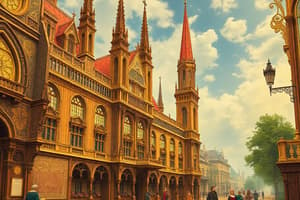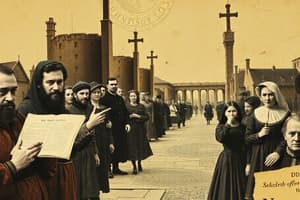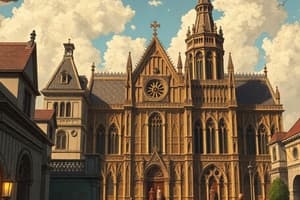Podcast
Questions and Answers
What was the Renaissance?
What was the Renaissance?
The great rebirth of art, literature, and learning in the 14th, 15th, and 16th centuries which marked the transition from the medieval to modern periods of European history.
When did the Renaissance take place?
When did the Renaissance take place?
The 14th, 15th, and 16th centuries.
Why did the Renaissance begin in Italy?
Why did the Renaissance begin in Italy?
Due to their diverse governing systems, prime location for trade, rich economy, and proximity to Roman culture.
Where did the Renaissance spread to?
Where did the Renaissance spread to?
Where did the Renaissance begin?
Where did the Renaissance begin?
Who were the Medici and why were they important?
Who were the Medici and why were they important?
What art style was popular during the Renaissance?
What art style was popular during the Renaissance?
What were some of Leonardo Da Vinci's accomplishments?
What were some of Leonardo Da Vinci's accomplishments?
Why is Leonardo Da Vinci considered a Renaissance man?
Why is Leonardo Da Vinci considered a Renaissance man?
Define humanism.
Define humanism.
Why was humanism important during the Renaissance?
Why was humanism important during the Renaissance?
What did Michelangelo accomplish?
What did Michelangelo accomplish?
Who painted the Mona Lisa and the Last Supper?
Who painted the Mona Lisa and the Last Supper?
Define vernacular.
Define vernacular.
Flashcards are hidden until you start studying
Study Notes
The Renaissance Overview
- The Renaissance was a cultural rebirth in art, literature, and learning, spanning the 14th to 16th centuries.
- Marked the transition from the medieval period to modern European history.
- Fostered new ways of thinking and the birth of humanism, emphasizing human potential and achievements.
Timeline of the Renaissance
- Took place during the 14th, 15th, and 16th centuries post-medieval era.
Origin and Spread
- The Renaissance began in Italy due to its diverse city governance, trade proximity to advanced civilizations, thriving economy, and connection to Roman culture.
- Spread to France, German States, Holland, and England, resulting in two distinct Renaissances:
- Southern Renaissance: focused on Italy.
- Northern Renaissance: encompassed the rest of Western Europe.
The Medici Family
- The Medici were a powerful Florentine merchant family, significant for sponsoring Renaissance artists and thinkers.
- Established power under Cosimo Medici in 1434, followed by descendant Lorenzo, a major patron of the arts.
Artistic Developments
- Renaissance thinkers rejected Medieval art styles, favoring classical art from Greece and Rome.
- Religious artwork dominated, but there was a growing interest in objective art and still life.
Leonardo Da Vinci
- Renowned for masterpieces like the Mona Lisa and The Last Supper.
- Involved in anatomy studies and invention, conceptualizing ideas not realized until centuries later.
- Considered a Renaissance man for his inquisitive nature and challenges to established Greek philosophies.
Humanism Defined
- An intellectual movement focusing on classical texts, human potential, and achievements.
- Emerged from a desire to reclaim intellectual dominance in Europe after the Middle Ages.
Importance of Humanism
- Emphasized learning and human accomplishments over religious contributions, driving Renaissance innovation and thought.
Michelangelo's Contributions
- A key figure in Renaissance art, known for sculpting David and various Pietà versions, and painting the Sistine Chapel's ceiling and wall.
- Architect of Saint Peter's Basilica, particularly noted for its dome.
Vernacular Language
- Refers to the everyday language spoken in a region, such as German or French, as opposed to Latin, which was less common during the Renaissance.
Niccolò Machiavelli's Significance
- Machiavelli played a crucial role in political philosophy during the Renaissance, contributing new ideas regarding governance and power.
Studying That Suits You
Use AI to generate personalized quizzes and flashcards to suit your learning preferences.




